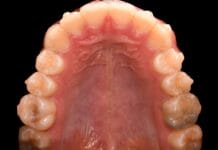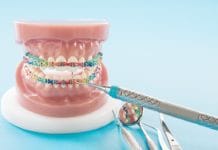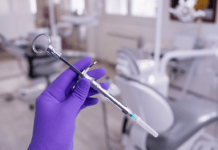An estimated seven million Americans are living with a prosthetic joint replacement. More women have prosthetic joint replacements than men. Interestingly, the states with the highest number of people living with prosthetic joint replacements are Florida, California, and Texas, while the lowest prevalence is in Alaska and Hawaii.1
Even though prophylactic antibiotics prior to dental treatment for the prevention of prosthetic joint infections have little evidence to support the practice, orthopedic surgeons are still recommending the use of prophylactic antibiotics, in some cases, for the life of the patient. This recommendation goes against the guidelines set for healthy patients by the American Dental Association (ADA), as well as the American Association of Orthopedic Surgeons (AAOS).2,3
The current guidelines set by the ADA and AAOS state that for healthy patients with no history of prosthetic joint infection, prophylactic antibiotics for the prevention of prosthetic joint infections are not recommended.2,3 However, in patients who have a history of prosthetic joint infections and/or those with uncontrolled diabetes, prophylactic antibiotics prior to dental treatment are reasonable.3
Recently, evidence to further support the current guidelines was published in the January 2023 edition of the Journal of the American Dental Association (JADA).4
Antibiotic Adverse Effects
Some people believe that antibiotics are inherently safe with little concern for adverse events. However, there are multiple reasons to avoid prescribing antibiotics to patients when they are not beneficial. The biggest and most threatening concern is the promotion of antimicrobial-resistant bacteria due to the overuse of antibiotics.5
According to the Centers for Disease Control and Prevention (CDC), antimicrobial-resistant bacteria were associated with over 5 million deaths worldwide in 2019. In the United States, more than 2.8 million antimicrobial-resistant infections occur each year. When you add Clostridioides difficile infections, an infection caused by antibiotic use but not associated with antimicrobial-resistant bacteria, the U.S. toll of all threats increases to 3 million.5
Other side effects associated with antibiotics include:6
- Stomach upset
- Photosensitivity
- Fever
- Yeast infections
- Allergic reactions
- Stevens-Johnson syndrome
- Hematological effects
- Cardiovascular complications
- Tendonitis
- Seizures
Therefore, it is important to weigh risks versus benefits when deciding whether a patient would benefit from an antibiotic.
Current Guidance on Prophylactic Antibiotics for Prevention of Prosthetic Joint Infection
The ADA’s Counsel on Scientific Affairs convened an expert panel to review published literature in 2012 regarding the need for prophylactic antibiotics to prevent prosthetic joint infections. At that time, the expert panel found no association between dental procedures and prosthetic joint infections. The panel was re-convened in 2014 to review a newer systematic review, and again, they found no association between dental procedures and prosthetic joint infections.2
Based on these findings, the ADA updated its guidelines in 2015, which state, “In general, for patients with prosthetic joint implants, prophylactic antibiotics are not recommended prior to dental procedures to prevent prosthetic joint infection.”7
The ADA goes on to state that when antibiotics are deemed necessary, it is most appropriate for the orthopedic surgeon to recommend the antibiotic regimen and provide the prescription.2
Newer Study Results
The recently published study in JADA aimed to “identify any association between invasive dental procedures and late prosthetic joint infections” as well as to determine if antibiotic prophylaxis reduced late prosthetic joint infection incidence following invasive dental procedures.4
For clarification, “late prosthetic joint infections” means the infection occurred more than three months after the original surgery to place the prosthetic joint.4
The data collected for the study included commercial, Medicare supplemental, dental, multi-state Medicaid, and MarketScan databases. This information was compared to hospital admissions for late prosthetic joint infections between January 2010 and December 2019. These were then matched with any cases that had a history of invasive dental procedures prior to the onset of the prosthetic joint infection. They also compared outcomes between patients that took prophylactic antibiotics and those that did not.4
The study results found no association between invasive dental procedures and the risk of subsequent late prosthetic joint infections. Further, they found no effect of prophylactic antibiotics in reducing late prosthetic joint infections.4
The authors of the study conclude that their data “suggests that the continued use of prophylactic antibiotics poses an unnecessary adverse drug reaction risk, and to the wider community due to its potential to promote the development of antibiotic resistance.”4
An interesting fact about prophylactic antibiotics for the prevention of prosthetic joint infections is that there are no randomized controlled trials to assess safety and efficacy. Furthermore, little evidence supports a causal association between invasive dental procedures and late prosthetic joint infections.4
Prophylactic antibiotics for the prevention of prosthetic joint infections are not recommended in the United Kingdom. However, they are still a common practice in the United States despite the lack of evidence to support them.4
The cost of providing prophylactic antibiotics in the U.S. is estimated to be around $59,640,000. This does not include the costs of adverse reactions or the cost of managing antimicrobial-resistant bacteria.4
In Closing
There is very little evidence to support the continued practice of providing prophylactic antibiotics for the prevention of prosthetic joint infections. Though the ADA and AAOS are more aligned in their recommendations, this was not true in the past. This misalignment among professional organizations caused confusion. Today, confusion remains among dental professionals and patients regarding the need for prophylactic antibiotics.
Dentists may often fear that they will be seen as negligent. As a result, they continue to prescribe unnecessary antibiotics for patients, including at the request of orthopedic surgeons. Deferring to the orthopedic surgeon and requesting they provide the prescription is not being negligent. In contrast, it is practicing nonmaleficence and providing the best care possible to patients based on evidence.
Further, taking antibiotics is not inherently safe. The idea of “better safe than sorry” is not a valid assessment of risk versus benefit.
If the patient’s orthopedic surgeon requests that the patient have prophylactic antibiotics to prevent a potential prosthetic joint infection, I encourage all dental professionals to follow current evidence-based guidelines and have the orthopedic surgeon who requires the prophylactic antibiotics provide the prescription for the patient. After all, it is the orthopedic surgeon who is “prescribing” the practice, therefore, they should be responsible for providing the prescription.
An ethical orthopedic surgeon would not provide a prescription for antibiotics to a patient with an abscessed tooth. Accordingly, a dentist should not take on the responsibility of managing the patient’s prosthetic joint replacement in any capacity, including preventing a potential infection.
Putting the responsibility on the orthopedic surgeon will make decision-making in the dental setting easier when determining the patient’s need and the proper antibiotic. Further, it will be in line with the ADA’s recommendations.
The majority of high-quality studies indicate there is no causal association between dental procedures and prosthetic joint infections. This recent study further supports the previous findings. It is in the best interest of the patient and the wider dental community to avoid providing prescriptions for unnecessary antibiotics.
Before you leave, check out the Today’s RDH self-study CE courses. All courses are peer-reviewed and non-sponsored to focus solely on high-quality education. Click here now.
Listen to the Today’s RDH Dental Hygiene Podcast Below:
References
- American Academy of Orthopaedic Surgeons. (2014, March 14). 2.5 Million Americans Living With Artificial Hip, 4.7 Million With Artificial Knee. ScienceDaily. www.sciencedaily.com/releases/2014/03/140314093737.htm
- Antibiotic Prophylaxis Prior to Dental Procedures. (2022, January 5). American Dental Association. https://www.ada.org/resources/ada-library/oral-health-topics/antibiotic-prophylaxis
- Prevention of Orthopaedic Implant Infection in Patients Undergoing Dental Procedures. (2012, December 7). American Academy of Orthopedic Surgeons. https://www.aaos.org/globalassets/quality-and-practice-resources/dental/pudp_guideline.pdf
- Thornhill, M.H., Gibson, T.B., Pack, C., et al. Quantifying the Risk of Prosthetic Joint Infections After Invasive Dental Procedures and the Effect of Antibiotic Prophylaxis. J Am Dent Assoc. 2023; 154(1): 43-52.e12. https://jada.ada.org/article/S0002-8177(22)00611-0/abstract
- About Antimicrobial Resistance. (2024, April 22). Centers for Disease Control and Prevention. https://www.cdc.gov/antimicrobial-resistance/about/index.html
- Side Effects of Antibiotics: What They Are and How to Manage Them. (2019, April 19). Healthline. https://www.healthline.com/health/infection/antibiotic-side-effects
- Sollecito, T.P., Abt, E., Lockhart, P.B., et al. The Use of Prophylactic Antibiotics Prior to Dental Procedures in Patients With Prosthetic Joints: Evidence-Based Clinical Practice Guideline for Dental Practitioners – A Report of the American Dental Association Council on Scientific Affairs. J Am Dent Assoc. 2015; 146(1): 11-16.e8. https://jada.ada.org/article/S0002-8177(14)00019-1/fulltext










